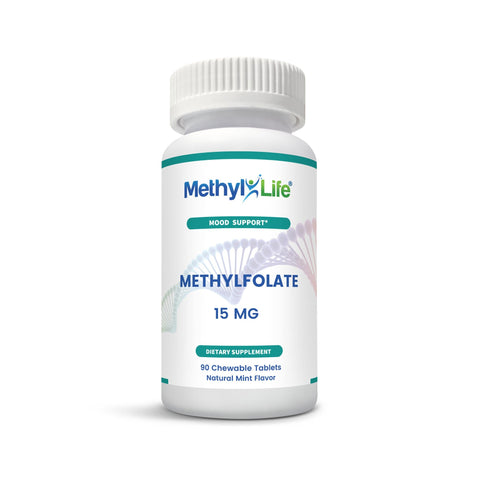
Methylfolate, Folate and Folic Acid
Updated On:
May 16, 2025Table of Contents
What is methylfolate and what is it for?
Methylfolate (5-MTHF or [(6S)-5-MTHF]) is the active form of folate, which means your body can use it immediately without any further conversion or metabolism.1 It’s a ready-to-go nutrient, which also makes it the most beneficial. All forms of folates - whether natural or synthetic - must first be converted to active methylfolate to be used in the body.
Methylfolate plays a key role in the re-methylation of homocysteine to produce methionine, which is then used to create S-adenosylmethionine (SAMe), the body’s main methyl donor and an essential component of neurotransmitter production2 (i.e. generating serotonin).
Methylfolate is the predominant physiological form of folate found in your blood. It’s required for the synthesis and repair of DNA, cell division, the metabolism of homocysteine, producing neurotransmitters, fetal development during pregnancy, and much more.3
Studies show that methylfolate is the most effective alternative to folic acid supplementation.4
What is folic acid and what is it for?
Folic acid is a synthetic form of folate, which means it’s made in a laboratory. It’s cheap to make and highly stable, so it’s often used in supplements and fortified foods (like breads, cereals, and snacks).
The problem with folic acid is that it’s not biologically active, so your body has to break it down first. This process requires several steps and a range of different enzymes, including the enzyme methylenetetrahydrofolate reductase (MTHFR), dihydrofolate reductase (DHFR) and serine hydroxymethyltransferase (SHMT). The MTHFR enzyme is produced by the MTHFR gene. However, if you’re one of 60-70% of people who have a mutation on the MTHFR gene, your body won’t be able to use folic acid as efficiently. DHFR is the enzyme responsible for converting folic acid to the usable form of folate, while SHMT (serine hydroxymethyltransferase) also plays a role in folate metabolism. Mutations on these genes can also affect how your body uses folic acid.
Our Founder’s Success Story:
"I have been studying methylfolate since 2011, long before most people had ever heard of it. I learned about it through a doctor who was able to save his son’s life using the nutrient. I was convinced not only by the science I learned from Dr. Neil Rawlins, but also by my own personal journey as well as the overwhelmingly positive responses my customers have had with the nutrient. Many have sent testimonials telling us how powerful this specific form of folate has been for their mood levels and pregnancy needs. The right kind of folate totally changed my life and that’s why I became a methylfolate expert and am obsessed with ensuring the methylfolate I take every day has the best chemistry, quality, and purity on the planet."
What is folate and what is it for?
Folate is the generic term for vitamin B9. Like the other B vitamins, it is water-soluble and cannot be stored by the body, so it must be replaced through diet or supplements. Folate naturally is present in many foods such as leafy green vegetables, legumes, eggs, citrus, and animal products.
Folate includes compounds that are chemically similar to those required during periods of rapid cell growth and division, such as DNA and RNA synthesis, which is critical during pregnancy. This is why it is so important for women who are pregnant or planning to conceive.
However, folate from food sources is generally unstable, and can be broken down by heat, light, and/or metal ions, which means cooking can reduce its bioavailability.5
What is methylated folic acid and what is it for?
Methylated folic acid is another term for methylfolate, the active form of folate. Unlike synthetic folic acid, methylfolate is ready for your body to use immediately.
What is the difference between methylfolate and folic acid and which is better for MTHFR?
Methylfolate is biologically active, while folic acid is not. Methylfolate can be used immediately by your body, even if you have the MTHFR gene mutation. This means methylfolate is better for those with MTHFR than folic acid.6
Folic acid is a man-made form of folate that must undergo a complicated four-step process in the body before it can become active. People with a MTHFR gene mutation cannot process folic acid properly, which means much of it remains unmetabolized. Unmetabolized folic acid can accumulate in the blood, and studies show that it may increase the risk of serious health issues.7
Methylfolate, Folate and Folic Acid
Key takeaways
-
 Methylfolate is the active, bioavailable form of folate readily absorbed by the body.
Methylfolate is the active, bioavailable form of folate readily absorbed by the body.
-
 Folic acid is a synthetic form of folate and may not be suitable for those with MTHFR.
Folic acid is a synthetic form of folate and may not be suitable for those with MTHFR.
-
 Methylfolate can bypass the MTHFR genetic mutations.
Methylfolate can bypass the MTHFR genetic mutations.
Product Recommendations
L Methylfolate 15 mg - A Mood-Boosting Supplement
$76.00
- Professional Strength - Ask Your Doctor
- High-Dose L Methylfolate 15 Mg for Natural Mood Support2
- 3rd-Party Tested for Purity, Potency & Safety
- 90 Vegan, Non-GMO, Chewable Mint Tablets
Frequently Asked Questions about Methylfolate, Folate and Folic Acid
There are a few reasons that you should not take folic acid and methylfolate together. Research shows that taking high doses of folic acid can block the transport of methylfolate to the brain where it is needed. In addition, excess folic acid can build up in the blood and brain fluid, where it can’t be used effectively and may even interfere with normal processes.8
For people with genetic conditions such as MTHFR, DHFR, and SHMT that affect folate processing, directly supplementing 5-MTHF is the best option. Folic acid (especially in high doses) should be avoided.
Methylfolate is more effective than folic acid for many reasons. Unlike folic acid, methylfolate is absorbed immediately by the body and doesn’t require any further processing. This makes it the most effective form for improving folate levels and supporting the many bodily processes that require folate, including brain function, neurotransmitter production, homocysteine metabolism, and normal development during pregnancy. Methylfolate also bypasses the MTHFR, DHFR and SHMT gene mutations.9
For optimal health, it is better to take methylfolate, the active form of folate. This is even more important if you have a MTHFR genetic mutation (or DHFR/SHMT mutation) and/or you are pregnant or trying to conceive.
While natural folate is available in many foods such as spinach, beans, animal products, and citrus, it isn’t a reliable or therapeutic source of folate. Food stores of folate are only very small, and easily destroyed by light or heat.
Folic acid is not ideal as it is a synthetic form of folate, and cannot be used in the body until it has been properly metabolized. If you have a mutation on the MTHFR/DHFR/SHMT genes, folic acid will not be processed properly.
The MTHFR gene mutation prevents the body from properly converting folic acid to its usable, active form. This means that you won't obtain the folate your body needs to function properly. This can lead to low folate levels and a range of health issues, such as increased homocysteine levels and clotting, depression, and neural tube defects.10
Research has also shown that high folic acid consumption can lead to unmetabolized folic acid syndrome, which is also linked to serious health issues. In addition, taking folic acid may lower the levels and activity of the MTHFR enzyme, causing a "fake" deficiency that can damage liver cells, especially in people with genetic MTHFR issues.11
No. Methylfolate is the active, bioavailable form of folate, while folic acid is the synthetic, inactive form. Methylfolate is readily absorbed by the body but folic acid must undergo a long conversion process before it can be used.
References
-
Lorena Carboni; "Active Folate Versus Folic Acid: The Role of 5-MTHF (Methylfolate) in Human Health"; Integrative medicine; 2022 Jul
https://pmc.ncbi.nlm.nih.gov/articles/PMC9380836/
-
Yen-Ming Chan, Regan Bailey, Deborah L O’Connor; "Folate"; Advances in nutrition; 2013 Jan
https://pmc.ncbi.nlm.nih.gov/articles/PMC3648733
-
US Preventive Services Task Force; "Folic Acid Supplementation to Prevent Neural Tube Defects"; US Preventive Services Task Force Reaffirmation Recommendation Statement | JAMA; 2023 Aug
https://jamanetwork.com/journals/jama/fullarticle/2807739
-
Lorena Carboni; "Active Folate Versus Folic Acid: The Role of 5-MTHF (Methylfolate) in Human Health"; Integrative medicine; 2022 Jul
https://pmc.ncbi.nlm.nih.gov/articles/PMC9380836/
-
Lorena Carboni; "Active Folate Versus Folic Acid: The Role of 5-MTHF (Methylfolate) in Human Health"; Integrative medicine; 2022 Jul
https://pmc.ncbi.nlm.nih.gov/articles/PMC9380836/
-
Maša Vidmar Golja, Alenka Šmid, Nataša Karas Kuželički, Jurij Trontelj, Ksenija Geršak, Irena Mlinarič-Raščan; "Folate Insufficiency Due to MTHFR Deficiency Is Bypassed by 5-Methyltetrahydrofolate"; Journal of clinical medicine; 2020 Sep
https://pmc.ncbi.nlm.nih.gov/articles/PMC7564482/
-
Christine M Pfeiffer, Maya R Sternberg, Zia Fazili, Elizabeth A Yetley, David A Lacher, Regan L Bailey, Clifford L Johnson; "Unmetabolized Folic Acid Is Detected in Nearly All Serum Samples from US Children, Adolescents, and Adults"; The Journal of nutrition; 2014 dec
https://pmc.ncbi.nlm.nih.gov/articles/PMC4336532
-
Tomoyuki Akiyama, Ichiro Kuki, Kiyohiro Kim, Naohiro Yamamoto, Yumi Yamada, Kazuya Igarashi, Tomohiko Ishihara, Yuya Hatano, Katsuhiro Kobayashi; "Folic acid inhibits 5-methyltetrahydrofolate transport across the blood–cerebrospinal fluid barrier: Clinical biochemical data from two cases"; JIMD Reports, Vol. 63, Iss. 6; 2022 Nov
https://onlinelibrary.wiley.com/doi/full/10.1002/jmd2.12321
-
Maša Vidmar Golja, Alenka Šmid, Nataša Karas Kuželički, Jurij Trontelj, Ksenija Geršak, Irena Mlinarič-Raščan; "Folate Insufficiency Due to MTHFR Deficiency Is Bypassed by 5-Methyltetrahydrofolate"; Journal of clinical medicine; 2020 Sep
https://pmc.ncbi.nlm.nih.gov/articles/PMC7564482/
-
Tauheed Hasan, Reetika Arora, Aniket Kumar Bansal, Reshmee Bhattacharya, Gurumayum Suraj Sharma, Laishram Rajendrakumar Singh; "Disturbed homocysteine metabolism is associated with cancer"; Experimental & Molecular Medicine | Open Access; 2019 Feb
https://www.nature.com/articles/s12276-019-0216-4
-
Karen E Christensen, Leonie G Mikael, Kit-Yi Leung, Nancy Lévesque, Liyuan Deng, Qing Wu, Olga V Malysheva, Ana Best, Marie A Caudill, Nicholas DE Greene, Rima Rozen; "High folic acid consumption leads to pseudo-MTHFR deficiency, altered lipid metabolism, and liver injury in mice"; The American journal of clinical nutrition; 2015 Jan
https://pmc.ncbi.nlm.nih.gov/articles/PMC4340065/
Related Articles

What is a MTHFR gene mutation?
Written By: Katie Stone - Naturopath

Signs and symptoms of MTHFR
Written By: Katie Stone - Naturopath

MTHFR Gene Mutation Treatment
Written By: Katie Stone - Naturopath

Like what you read?
Please subscribe to get more content like this sent to your inbox.
Share This Article
Browse Categories
Product Recommendations
L Methylfolate 15 mg - A Mood-Boosting Supplement
$76.00
NEW CEREBROFOLATE™ - Improved Purity &
Potency



